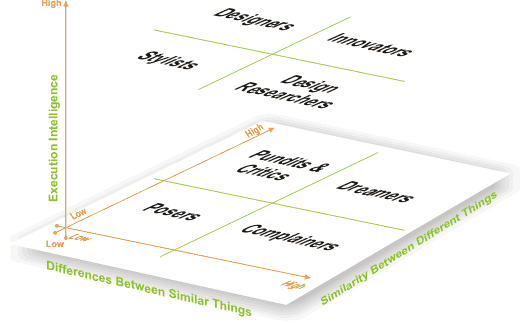My appologies for the the lame title–I just couldn’t come up with anything less bad. Regardless…
Blogrium has an interesting post on the sociology of innovation and the psychological perception factors that are conducive to fostering innovation within groups.

I was immediately struck by the fact that this is a model of product design as a professional and multi-disciplinary practice. Indeed many designers claim that design is a problem solving endeavour (top-right). I contend that solving is only part of the equation; modeling and understanding the problem (bottom-left) is the other half.
Furthermore most design practice seems to be trapped in derivative stylization (bottom-right). Need proof? Pick up any design magazine. Chances are regardless of which one or which time or year, it will feature the winners of some kind of mind-numbingly sterile design competition. In it you will find that what passes for award winning design is really little more than a predictable and conservative fashion show of usual suspects.
And finally design at its best, mixes with other disciplines like engineering marketing to give birth to real innovation (top-left). This means that design is not itself innovaton (and one shouldn’t conflate the two) but strongly related to innovation.
So these four quadrants seem to cover the reality of product design and development quite nicely. However, I was still unsatisfied. Something was missing. And toward the end of the post there it was: constraints. The 2-D model does not include one’s ability to navigate constraints.
By constraint navigation I’m refering to execution intelligence: the ability to successfully act on what has been percieved. Sure you can see differences and similarities, but can you take that vision to market (financial market, product market, idea market, what ever)? No market, no innovation.
So I included a third dimension and tweaked some of the terms (in my cumudgeonly way) to come up the following cube: Innovation^3.

That looks pretty good and actually ties everything together quite nicely. I’m sure there’s other dimensions that could be added to the model, but these seem to be the most important ones.
Also, not sure you meant to link Blogrium to trendwatching.com?
Low/Low “What Jeff said”
Btw, w.r.t. to your 3D model, I’m sending you a PDF of Theodore Levitt’s “Creativity is Not Enough” HBR 1963 – you have visualized in one model the gist of what his article attempts to articulate. That is one example of what designers can bring to the table, with reference to our previous discussion in the comments of my blog, the ability to visualize and synthesize the ‘whole’ in one clear diagram what otherwise takes 9 pages of closely written material to convey.
Jeff,
Your right–my mistake. I’ve fixed the link. Thanks for pointing that out.
Niti,
Thanks. I’ll definately read that. Recently I’ve been going over some older HBR article on innovation and breakthrough thinking. they’re all about 10 years old now, and its interesting to evaluate them with a bit of historical perspective. People were writing a lot of crap back in that day, but there is also an awful lot that holds up very well (especially from Peter Drucker).
I’m curious to see how something written in 1963 speaks to today–especially given the timeliness of the topic (creativity) and the cautionary that it may not be enough (a refreshing reality check in today’s innovation buzz).
The name Theodore Levitt sounds familiar… I’ll have to dig through my crates of old papers…
Thanks again.
Very cool, i like the high vs low intelligence difference.
Funny you say that, because it was exactly that kind of inherent judgment that made Dirk uncomfortable. You should check out what he has to say.